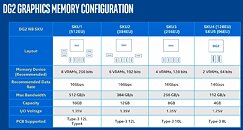
Intel Arc "Alchemist" A750 Reaches End-of-Manufacture
Intel has confirmed that its Arc A750 graphics card has reached end-of-life, as outlined in Product Change Notification #856777‑00 published yesterday. This announcement marks the beginning of the end for a model that arrived just two and a half years ago, and it offers partners a clear timetable for winding down orders and shipments. Customers should mark June 27, 2025, as their final opportunity to submit discontinuance orders for the Arc A750. After that date, no new orders will be accepted. All remaining units are slated for delivery by September 26, 2025. Intel recommends that system builders, integrators, and distributors assess their inventory and projected needs now and then place any last orders before the cutoff. Should questions arise, field sales representatives stand ready to assist. Do note that end of life here means end of manufacturing, not end of support. Intel will continue to provide driver and quality of life updates to these Arc Alchemist GPUs.
When it launched in October 2022, the Arc A750 staked its claim in the performance segment of Intel's market-entry discrete GPU lineup. Based on the DG2‑512 processor in its ACM‑G10 form, the card leveraged TSMC's 6 nm to pack 21.7 billion transistors into a 406 square millimeter die. With 3,584 shading units, 224 texture units, and 112 ROPs, it delivered strong raster throughput. Its 28 ray‑tracing cores and 448 tensor cores brought hardware‑accelerated lighting and machine-learning inference within reach of mainstream gamers and creators alike. At the board level, the A750 features 8 GB of GDDR6 memory, running at an effective 16 Gbps across a 256-bit bus, which yields 512 GB/s of bandwidth. A base clock of 2,050 MHz could be boosted to 2,400 MHz, while a dual-slot design drew up to 225 W via one 6-pin and one 8-pin connector. Video outputs included HDMI 2.1 and three DisplayPort 2.0 ports, all bridged to the host system over PCI‑Express 4.0 x16.
When it launched in October 2022, the Arc A750 staked its claim in the performance segment of Intel's market-entry discrete GPU lineup. Based on the DG2‑512 processor in its ACM‑G10 form, the card leveraged TSMC's 6 nm to pack 21.7 billion transistors into a 406 square millimeter die. With 3,584 shading units, 224 texture units, and 112 ROPs, it delivered strong raster throughput. Its 28 ray‑tracing cores and 448 tensor cores brought hardware‑accelerated lighting and machine-learning inference within reach of mainstream gamers and creators alike. At the board level, the A750 features 8 GB of GDDR6 memory, running at an effective 16 Gbps across a 256-bit bus, which yields 512 GB/s of bandwidth. A base clock of 2,050 MHz could be boosted to 2,400 MHz, while a dual-slot design drew up to 225 W via one 6-pin and one 8-pin connector. Video outputs included HDMI 2.1 and three DisplayPort 2.0 ports, all bridged to the host system over PCI‑Express 4.0 x16.

























































